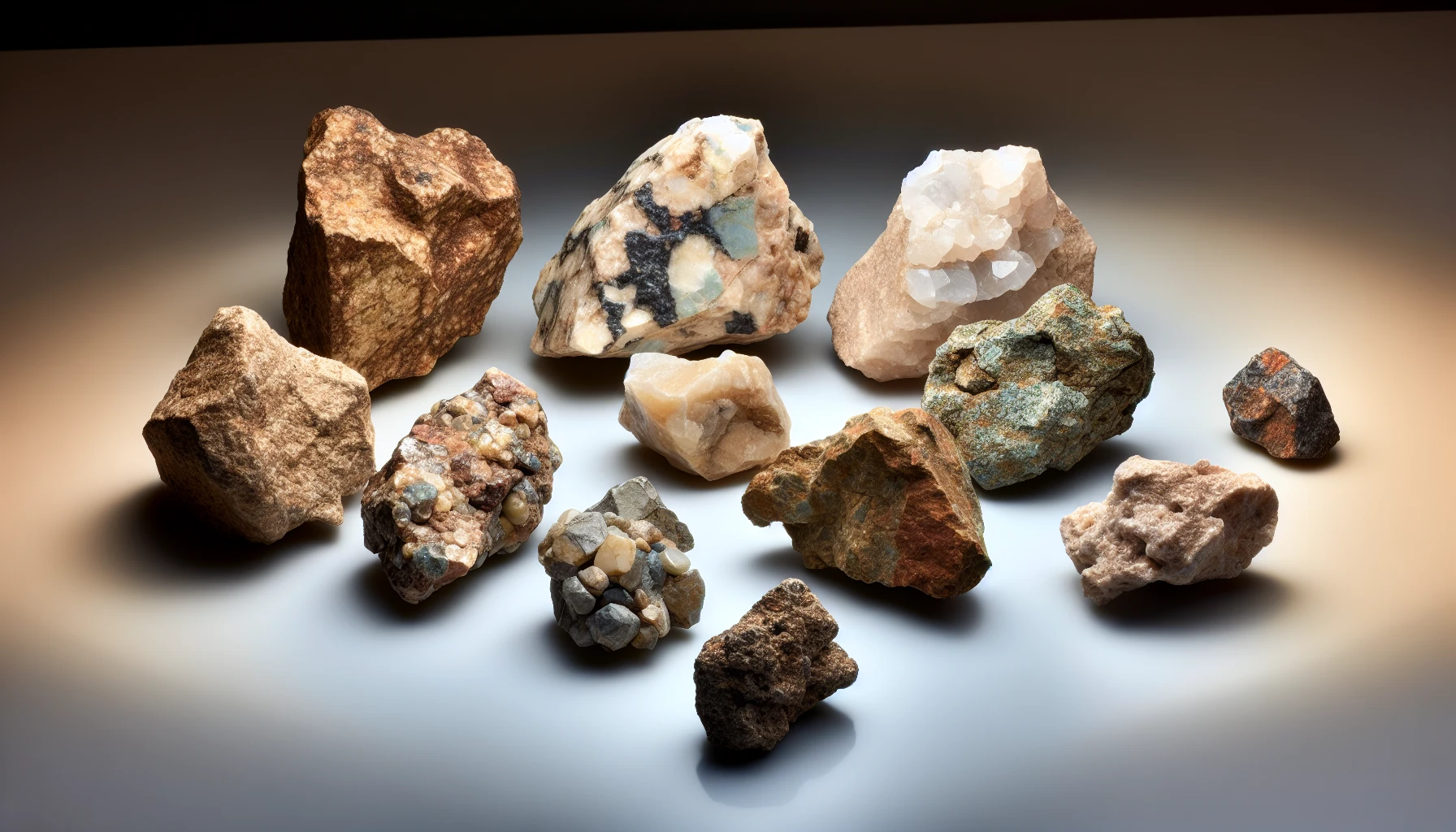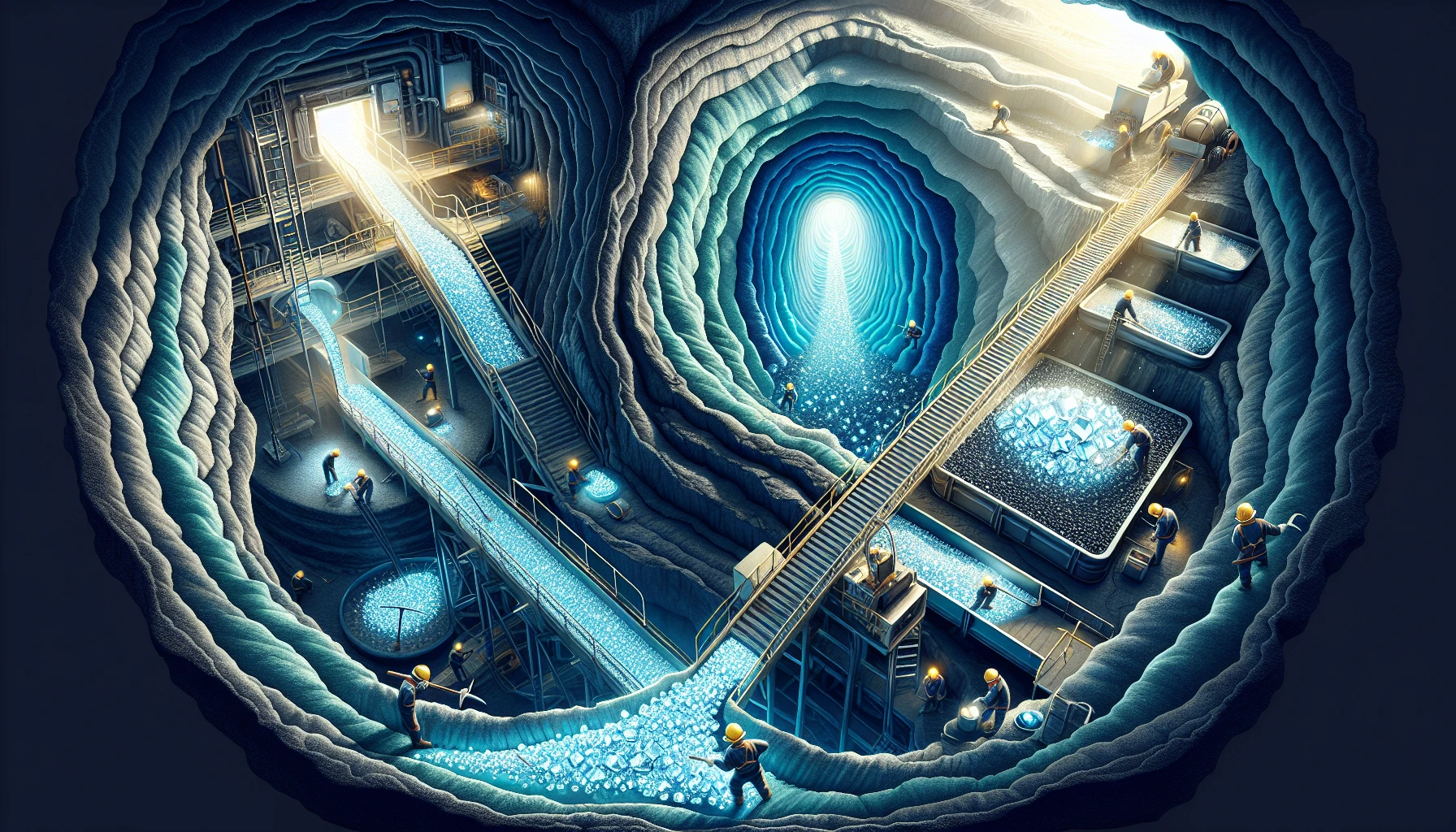Kimberlite can be identified by its color, texture and brecciation, as well as advanced techniques such as geochemical analysis and magnetism tests. Kimberlite is an igneous rock with diamonds formed deep within Earth’s mantle. Kimberlite plays a critical role in diamond mining industry, providing insights into the composition of Earth’s mantle.
Imagine unearthing a sparkling diamond from a seemingly ordinary rock. That’s the exciting possibility when dealing with kimberlite, a rare, diamond-bearing igneous rock. The ability to locate and accurately identify kimberlite is essential for diamond mining and understanding our planet’s geology. Get ready to uncover the fascinating world of kimberlite and learn how to distinguish this valuable rock from its imitators, by mastering “how to identify kimberlite”.
The Basics of Kimberlite

Kimberlite, a unique igneous rock bearing diamonds, originates deep within Earth’s mantle and is carried to the surface by volcanic eruptions. These eruptions create carrot-shaped structures called kimberlite pipes, which are primarily found in ancient sections of Earth’s crust formed by various igneous rocks. Due to its diamond content, kimberlite has been at the center of the diamond mining industry, sparking events such as South Africa’s famous diamond rush.
The formation process of kimberlite occurs in the upper parts of Earth’s mantle, where the necessary pressure and heat required for diamond growth are present. As kimberlite pipes form, they serve as conduits for material from the mantle, including diamonds, to reach the Earth’s surface. The mineral composition of kimberlite includes:
- Olivine
- Garnet
- Serpentine
- Calcite
- Rutile
- Magnetite
These minerals are found in various formations such as dark gray country rock, blue ground, and yellow ground.
Formation and Characteristics
Kimberlite rock is a unique formation that occurs in carrot-shaped pipes through volcanic activity. It is characterized by:
- A fine-grained texture
- High porosity
- The presence of magnetite
- Cool shades such as greenish, bluish, or gray
- A rough and sometimes crumbly texture
These characteristics can help differentiate kimberlite from other rocks.
The creation of kimberlite involves diverse processes such as transient fluidization and hydrovolcanic activity. This is evidenced by the angular fragments present in the rock, known as brecciation. Analyzing these fragments and other features like facies reveal much about the explosive nature of kimberlite eruptions and their genesis near the Earth’s surface.
Diamond-Bearing Kimberlite
Diamond-bearing kimberlite plays a significant role in the diamond mining industry, as it is a major source of diamonds. However, finding kimberlite does not guarantee the presence of diamonds; only approximately 1% of kimberlite formations contain diamonds.
Diamonds form in the mantle and are transported to the surface by ascending kimberlitic magma during volcanic eruptions. The extraction process involves:
- Mining the kimberlite ore
- Processing the ore to separate the diamonds from the rock, using techniques such as open-pit mining or underground mining
- Crushing and processing the ore to extract the diamonds
Identifying Kimberlite: Visual Clues and Tests

Successful diamond mining heavily relies on the accurate identification of kimberlite. Visual clues and tests can help differentiate kimberlite from other rocks. Observing the color, texture, and brecciation of a rock can aid in determining its likelihood of being kimberlite or a different type of rock.
Color and Texture
Kimberlite, including blue ground kimberlite, typically displays cool shades like greenish, bluish, or gray, with a rough and sometimes crumbly texture. These colors and textures can help distinguish kimberlite from other rocks. However, it is important to note that color alone cannot confirm if a rock is genuine kimberlite.
The texture of kimberlite is unique and pyrope garnets rich. It has a porphyritic texture, featuring large, rounded crystals surrounded by a fine-grained ground mass. This texture can provide valuable information about the rock’s formation and help differentiate it from other rocks with similar colors.
Brecciation
Brecciation refers to the presence of angular fragments within the rock, which is a common feature in kimberlite. This characteristic can help identify kimberlite, as it provides evidence of the fluidization and hydrovolcanic processes that occurred during the formation of the rock.
Observing the angular fragments in a rock reveals information about the explosive nature of kimberlite eruptions and their genesis near the surface. This information can help you determine if the rock is kimberlite or another type of rock formed through different geological processes.
Advanced Techniques for Kimberlite Identification
For more accurate identification of kimberlite, advanced techniques such as geochemical analysis and magnetism tests can be employed. These methods provide a deeper understanding of the rock’s composition and properties, helping to differentiate kimberlite from similar rocks more conclusively.
Geochemical Analysis
Geochemical analysis entails the examination of rocks and soils’ chemical composition to pinpoint specific indicators linked to kimberlite. This analysis can involve identifying indicator minerals, such as garnets or ilmenite, commonly found in kimberlite. It may also involve measuring the concentrations of certain elements or isotopes that are characteristic of kimberlite. Conducting a geochemical analysis allows geologists to estimate the likelihood of kimberlite presence in a specified area.
This method not only helps differentiate kimberlite from other similar rocks but also provides valuable information about the rock’s formation and the processes occurring within the Earth’s mantle. Geochemical analysis is an essential tool for geologists and diamond explorers, as it offers a more in-depth understanding of the composition and properties of kimberlite and the environment in which it forms.
Magnetism Test
Testing for magnetism can help identify the presence of magnetic minerals within the rock, which can indicate whether the rock is kimberlite or not. Kimberlite possesses a strong magnetism due to the trace mineral magnetite, allowing for its identification.
A magnetism test employs a strong magnet to establish if there is any attraction to the rock. If the rock contains magnetic minerals, the magnet will appear to pull or adhere to it. This test is beneficial in identifying kimberlite and provides another method to differentiate it from other similar rocks.
Common Kimberlite Imposters

Several rocks can be mistaken for kimberlite, including serpentine, lamproite, and peridotite. These rocks may share some similarities with kimberlite in terms of appearance or composition, but they have distinct differences that can help differentiate them from genuine kimberlite.
Serpentine
Serpentine rocks have a waxy or silky appearance and can be mistaken for kimberlite. However, there are distinct differences between the two. Serpentine is generally green in color and has a mottled appearance with a slick texture. It is mainly composed of magnesium silicate minerals, including lizardite, chrysotile, and antigorite.
Assessing the rock’s hardness can distinguish serpentine from kimberlite, given that serpentine is typically softer than kimberlite.
Lamproite
Lamproite is similar to kimberlite but has unique properties and characteristics that can be used to differentiate the two. Lamproite is a volcanic rock that is known for its elevated potassium content and may contain diamonds. It is abundant in other minerals, such as mica, amphibole, and pyroxene, and has a porphyritic texture with sizable crystals embedded in a fine-grained matrix.
The creation process of lamproite deviates from that of kimberlite in terms of the fluids involved, marking a clear distinction from kimberlite.
Peridotite
Peridotite can also be mistaken for kimberlite but has its own unique properties and benefits. Peridotite is a silicate mineral that is typically abundant in iron and/or magnesium and can have a variety of chemical compositions. It may contain well-formed olivine crystals surrounded by other minerals and has a texture similar to granite.
A density test can serve to distinguish kimberlite from peridotite, offering an extra method for precise identification.
Locating Kimberlite Deposits

Identifying kimberlite deposits is a significant step in diamond mining. By using techniques such as indicator minerals, the Pandanus candelabrum plant, and geophysical exploration techniques, you can pinpoint potential kimberlite deposits and increase the chances of finding diamonds.
Indicator Minerals
Indicator minerals are minerals found in the same environment as kimberlite and can help pinpoint potential deposits. These minerals include:
- Garnet
- Chromite
- Ilmenite
- Clinopyroxene
- Olivine
- Zircon
Analyzing the presence and abundance of these minerals in an area enables geologists to estimate the potential for diamond-bearing environments in the lithospheric mantle.
The identification and analysis of indicator minerals are of paramount importance in diamond exploration and resource evaluation of kimberlites.
Pandanus Candelabrum Plant
The Pandanus candelabrum plant is known to grow in areas with kimberlite deposits, making it a useful tool for locating potential deposits. This plant, also known as the chandelier tree, is native to diamond-rich areas, such as diamond mines. It requires specific growth conditions, including:
- Its dioecious nature
- A height of 10-12 meters
- Spiny stiff leaves and stilt roots
- A preference for soil that is rich in kimberlite
Identifying areas where this plant thrives allows geologists to refine the search for potential kimberlite deposits.
Geophysical Exploration Techniques
Geophysical exploration techniques, such as ground-penetrating radar and magnetic surveys, can help identify kimberlite pipes and other geological structures. Ground-penetrating radar works by transmitting a pulse into the ground and recording the echoes that arise from subsurface objects. In the context of identifying kimberlite, ground-penetrating radar surveys can detect kimberlite intrusions due to the difference in properties between kimberlite and the surrounding rocks.
Magnetic surveys can detect anomalies in the magnetic field that may indicate the presence of kimberlite pipes or deposits. These methods are widely employed in kimberlite exploration due to their efficacy and cost-effectiveness.
The Role of Kimberlite in Diamond Mining

Kimberlite plays a significant role in diamond mining, contributing to both diamond extraction and insights into the Earth’s mantle. Accurate identification and location of kimberlite deposits are essential for successful diamond mining and understanding the processes occurring in the deep Earth.
Diamond Extraction
Diamond extraction from kimberlite involves processing the rock to separate diamonds from other minerals and materials. There are three distinct mining techniques used to extract diamonds from kimberlite: alluvial mining, pipe mining, and marine mining.
Once the ore is extracted, it is crushed and processed to extract the diamonds. Precise identification and location of kimberlite deposits are key to the success of these mining techniques.
Insights into Earth’s Mantle
Examining kimberlite yields useful information about the subcontinental mantle and deep Earth processes, enhancing our understanding of the planet’s geology. Kimberlites are the only known volcanic deposits that have originated from the Earth’s deep mantle and contain fragments of both crustal and mantle material, brought to the surface as molten rock by kimberlite magma. As magma rises, these unique formations provide valuable insights into our planet’s inner workings.
The presence of diamonds in kimberlite suggests the existence of diamond-forming conditions in the mantle, providing insights into the composition and processes of this enigmatic layer of our planet.
Summary
In conclusion, understanding the unique properties and characteristics of kimberlite, along with the various methods for identification and location, is essential for successful diamond mining. By accurately identifying and locating kimberlite deposits, we can not only unlock the hidden treasures within these rare rocks but also gain valuable insights into the Earth’s deep mantle and the geological processes that shape our planet.
Frequently Asked Questions About “How to Identify Kimberlite”
How can you tell if a rock is kimberlite?
Kimberlite can be identified by its fine-grain texture, its blue or yellow color, and/or the presence of diamonds and other gems in the rock. Additionally, it is potassic to ultrapotassic ultrabasic rock with inequigranular texture, making it distinguishable from other types of rocks.
What does kimberlite look like?
Kimberlite is a dark-coloured, heavy intrusive igneous rock with a porphyritic texture, consisting of large rounded crystals surrounded by a fine-grained matrix. It often appears bluish-green and may contain diamond particles within its matrix.
Is kimberlite magnetic?
Kimberlite typically produces magnetic anomalies, but this decreases significantly with weathering, resulting in the material becoming practically non-magnetic.
Do all kimberlites contain diamonds?
Most kimberlites and lamproites do not contain diamonds, with only about 3 dozen of several hundred African kimberlites having been found to contain diamonds, and even those are too lean to be mined economically.
What is the primary source of diamonds?
Kimberlite is the primary source of diamonds, forming deep within Earth’s mantle and being a rare diamond-bearing igneous rock.